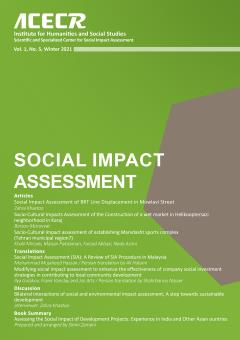-
-
List of Articles
-
Open Access Article
1 - Social Impact Assessment of BRT Line Displacement in Mowlavi Street
Zahra Khastoo -
Open Access Article
2 - Socio-Cultural Impacts Assessment of the Construction of a wet market in Helikooptersazi neighborhood in Karaj
Borzoo Morovvat -
Open Access Article
3 - Socio-cultural impact assessment of establishing Marvdasht sports complex (Tehran municipal region7)
Khalil Mirzaei Marjan Pakdaman Farzad Abbasi neda Azimi -
Open Access Article
4 - Social Impact Assessment (SIA): A Review of SIA Procedure in Malaysia The International Journal of Social Sciences and Humanities Invention 5(4), 4550-4557, 2018
Mohammad Mujaheed Hassan Ali Hatami (Persian translation) -
Open Access Article
5 - Modifying social impact assessment to enhance the effectiveness of company social investment strategies in contributing to local community development
Frank Vanclay Ilya Gulakov Jos Arts sh n -
Open Access Article
6 - Bilateral interactions of social and environmental impact assessment A step towards sustainable development (Interview with “Ismail Salehi”)
Zahra Khastoo (Interviewer) -
Open Access Article
7 - Book summary Assessing the Social Impact of Development Projects: Experience in India and Other Asian Countries
Simin Zamani (Prepared and arranged)
-
The rights to this website are owned by the Raimag Press Management System.
Copyright © 2017-2025







